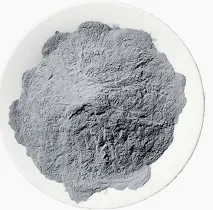Silver Powder / Ag Powder
Formula | Silver Powder / Ag |
Synonyms | Silver Powder, Silver Nanoparticles, Ag nanopowder |
Appearance | Gray Powder, near spherical–based on particle size |
Particle Size | 1-8 um, 500-1000 nm, can be customized upon request |
Melting Point | 960.8 °C |
Density | 10.5 g/cm 3 |
Bulk Density | 0.6-0.9 g/cm3 |
Purity | 4N, 99.99% |
Description of Silver Powder / Ag Powder
Silver powder is also known as silver dust or silver particulate. In the nanotechnology and electronics industries, it may also be referred to as silver nanoparticles (for very fine particles) or silver flakes (when the particles are larger and flake-like in shape).
Silver powder can be processed into nanoparticles, submicron, and micrometer-sized particles, each with distinct properties. Nanoparticles (1-100 nm) offer unique optical, electrical, and antimicrobial properties, ideal for medical, electronic, and catalytic applications. Submicron particles (100-1000 nm) balance enhanced properties and processability, making them suitable for conductive inks and adhesives in printed electronics. Micrometer-sized particles (1-1000 µm) retain more bulk properties and are used in traditional applications like conductive materials, catalysis, and fillers in composites.
Princeton Powder is a leading supplier of Silver powder. With our expertise, we are confident in supporting your projects effectively and provide you with reliable solutions. Silver Ag powder is for sale.
Chemical Composition
Silver Powder / Ag Powder Certificate of Analysis–% | |||||||
Ag | Pb | Cd | Fe | Cu | Sn | As | Sb |
≥99.99 | ≤0.005 | ≤0.001 | ≤0.001 | ≤0.003 | ≤0.001 | ≤0.001 | ≤0.002 |
Particle Size distribution
1-8 um, 500-1000 nm, can be customized upon request
Applications
Electronics: Silver powder is widely used in the production of conductive inks, pastes, and adhesives for printed circuit boards (PCBs), RFID tags, and other electronic components. It ensures efficient electrical conductivity in electronic devices.
Medical: Due to its strong antimicrobial properties, silver powder is used in wound dressings, coatings for medical devices, and antibacterial coatings in various healthcare products. It helps prevent infections and promotes healing.
Catalysis: Silver powder serves as a catalyst in chemical reactions, particularly in the production of formaldehyde and in the oxidation of ethylene. Its high surface area enhances reaction efficiency.
Coatings and Paints: Silver powder is added to coatings and paints to provide antimicrobial and antifungal properties, as well as to create reflective surfaces. It is used in environments where hygiene is critical.
Photovoltaics: In solar cells, silver powder is used to create conductive layers and contacts, improving the efficiency of photovoltaic cells by enhancing electrical conductivity.
Jewelry and Decorative Applications: Silver powder is also used in decorative arts, such as in the production of silver-colored paints and coatings, and in jewelry manufacturing for creating intricate designs.
Spherical Silver Powder /Ag Powder Reference
Preparation and characterization of fine silver powder with colloidal emulsion aphrons
- Two kinds of silver powder samples with typical shapes, one is the “nano-porous microsphere” prepared with CEAs and the other is the linear silver powder prepared with ELMs, were characterized by thermogravimetry (TG)–differential thermal analysis (DTA), X-ray powder diffraction analysis and field emission scanning electron microscope (FESEM).
Silver powder has become an increasingly popular material across a wide range of industries due to its conductive, antimicrobial and stable properties at high temperatures. Major application areas include: Conductive adhesives, pastes and fillers. Conductive inks and prints.
Silver powder is used in 3D printing for creating conductive components in electronics, leveraging its excellent electrical conductivity. It enables the production of intricate parts through metal additive manufacturing techniques like SLM, ideal for high-performance applications. The powder is also used in jewelry for detailed, customized designs, and in medical devices for its biocompatibility and antimicrobial properties. Silver powder enhances the functionality and precision of 3D-printed objects across various industries.
Chemical Reduction: A common method where a silver salt, such as silver nitrate (AgNO₃), is dissolved in water and then reduced using a reducing agent like sodium borohydride (NaBH₄) or hydrazine. This process precipitates silver particles, which are then washed, filtered, and dried to produce fine silver powder.
Atomization: In this method, molten silver is atomized using high-pressure gas or liquid, breaking it into fine droplets that solidify into powder as they cool. Atomization is often used to produce silver powder with controlled particle sizes for specific applications.
Electrolytic Deposition: Silver powder is produced by electrolytically depositing silver onto a cathode from a silver salt solution. The deposited silver is then scraped off, washed, and dried to create the powder. This method produces high-purity silver powder with a specific particle size.
Mechanical Milling: Silver powder can also be produced by mechanically grinding solid silver into fine particles using ball mills or other milling equipment. This method is less common but useful for producing powders with larger particle sizes.

